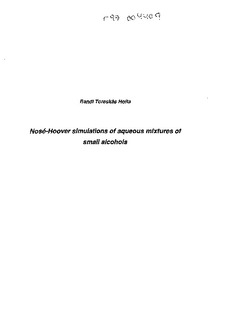| dc.description.abstract | We have performed constant energy and constant temperature equilibrium molecular dynamics simulations of model liquids of water, methanol, and ethanol, and of the binary aqueous mixtures of the alcohols at mole fractions alcohol of 0.25, 0.50, and 0.75 at room temperature. The total number of molecules is 256 and the integration timestep is 0.5fs. The molecules are modelled with rigid, nonpolarizable effective site potentials. The TIP4P model is applied for water, and the OPLS models for methanol and ethanol (trans). The thermostatically controlled simulations are performed within the Nose-Hoover formalism, with separate temperature control of the translational and rotational degrees of freedom. Reservoir coupling in the mixtures is determined as a weighted average of the liquid values. We present enthalpies of vaporization and excess configurational energies for the mixtures. Further, we show all radial site-site correlation functions for the self- and cross-interactions. We also present results for self-diffusion coefficients for the components, and the velocity auto correlations functions. The NVT simulations are investigated with respect to the possibility of reproducing the canonical ensemble. We find that the simulations are not entirely within the premises of the canonical ensemble. We suggest that this is due to a too weak coupling (too large heat bath mass). The results are nevertheless found to be in good agreement with experiments and published simulational studies. The NVE simulations for the mixtures reproduce the desired temperature well. The energy conservation is good and improves with decreasing water content. Effects of using only trans-ethanol might be seen for the self-diffusion coefficients. Structural results for both the model alcohols are found to be consistent with V-chains. Upon addition of water, methyl-methyl coordination numbers for both alcohols decrease less than the hydroxyl coordination numbers. | |
